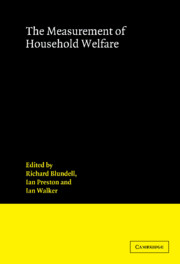Book contents
- Frontmatter
- Contents
- List of contributors
- 1 An introduction to applied welfare analysis
- 2 Measuring the cost of children: a theoretical framework
- 3 The collective approach to household behaviour
- 4 Ordinal and cardinal utility: an integration of the two dimensions of the welfare concept
- 5 The determination of welfare in nonintact families
- 6 Female labour supply, housework and family welfare
- 7 Engel equivalence scales in Sri Lanka: exactness, specification, measurement error
- 8 Measuring the life-cycle consumption costs of children
- 9 Family fortunes in the 1970s and 1980s
- 10 Ethically-consistent welfare prescriptions are reference price-independent
- 11 The effect of systematic misperception of income on the subjective poverty line
- Index of names
- Index of subjects
3 - The collective approach to household behaviour
Published online by Cambridge University Press: 13 January 2010
- Frontmatter
- Contents
- List of contributors
- 1 An introduction to applied welfare analysis
- 2 Measuring the cost of children: a theoretical framework
- 3 The collective approach to household behaviour
- 4 Ordinal and cardinal utility: an integration of the two dimensions of the welfare concept
- 5 The determination of welfare in nonintact families
- 6 Female labour supply, housework and family welfare
- 7 Engel equivalence scales in Sri Lanka: exactness, specification, measurement error
- 8 Measuring the life-cycle consumption costs of children
- 9 Family fortunes in the 1970s and 1980s
- 10 Ethically-consistent welfare prescriptions are reference price-independent
- 11 The effect of systematic misperception of income on the subjective poverty line
- Index of names
- Index of subjects
Summary
Microeconomic theory essentially considers the household as the basic decision unit. The usual tools of consumer theory have been applied at the household level; in particular, the latter has been described by a single utility function which is maximised over a single budget constraint. This ‘traditional’ framework, however, has recently been challenged by several authors, who have developed so-called ‘collective’ models of household behaviour. The various contributions belonging to the collective approach share a fundamental claim, namely that a household should be described as a group of individuals, each of whom is characterised by particular preferences, and among whom a collective decision process takes place. The first objective of this chapter is to discuss some basic methodological issues involved in the collective approaches. A second objective is to review a particular class of collective models, based upon the Pareto efficiency hypothesis, that have recently been developed. Finally, the collective approach has important consequences for the measurement – and, as a matter of fact, for the very definition – of household welfare. This issue will be discussed in the final section of the chapter.
Models of household behaviour: some methodological issues
‘Collective’ versus ‘traditional’ approaches
The advantages of the traditional approach are well known. Essentially, the traditional setting allows a direct utilisation of the consumer theory toolbox. This includes generating testable restrictions upon demand functions, recovering preferences from observed behaviour in an unambiguous way, and providing an interpretation to empirical results.
- Type
- Chapter
- Information
- The Measurement of Household Welfare , pp. 70 - 85Publisher: Cambridge University PressPrint publication year: 1994
- 39
- Cited by



